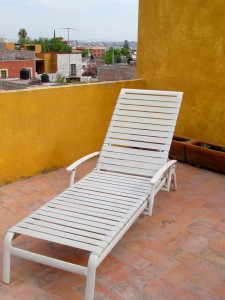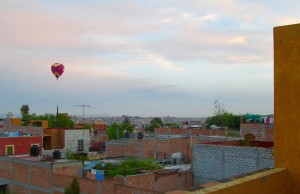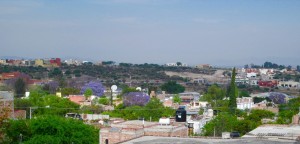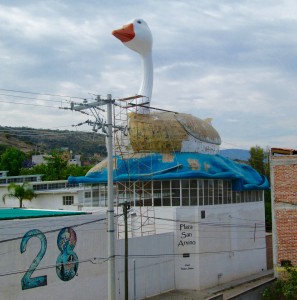The moment I first stepped onto the azotea, I knew this was the casa for me. “Azotea” – rooftop terrace – soon became my newest favorite Spanish word and my favorite place in the house to be.

In the six months I’ve now lived in beautiful San Miguel de Allende, Mexico, I’ve spent most of my daylight, at-home time up here – savoring the glorious seemingly never-ending view, hanging just-washed laundry in the fresh air, eating midday meals on my chaise longue, being embraced by my beloved sunshine, watering my potted plants, reading, writing, thinking. . . . My azotea has become my hideaway, my bulwark, my perch. Plus, my life metaphor:
Because I’ve always tended to think of life as one big mountain climb, whenever I climb the steep, straight stairway to my azotea from the second floor of this sweet casa, I feel I’ve arrived. I stand by the wall and look out on the busy, sprawling mountain town below, and I feel strangely, blissfully removed from it. As a retired person now, I am freed from all that hectic to-ing and fro-ing. I’m no longer in anybody’s work force. I’m no longer a cog in any country’s machinery.
So I’ve got good news for the not-yet-retired: It can be like reaching a mountaintop and planting your own colorful flag beneath a limitless blue sky.
Often in the early morning from my azotea I can see brightly colored hot-air balloons ascend and then float out of sight. I consider their sightings good omens for the day. (See “Balloons” WOW post of March 26.)
In the afternoon, while having lunch and reading a book, I sometimes look out at the jacaranda trees now in bloom below and I reminisce about another time and place. (See “Jacaranda Time” post of April 2.)
And then, occasionally, at sunset I’m treated to a magnificent, fiery, end-of-day show:
Of course, as with other aspects of life, there is also a measure of absurdity in what I see from my azotea. Take, for example, the big duck installation (“el pato gigante,” as everyone here calls it) across the street from me. It’s the size of a large, several-story house, and it sits on top of a hotel that’s never, to my knowledge, been open for business.
The sight of el pato gigante from my private parapet makes me smile. And it’s a daily reminder to me of my favorite, unanswerable, existential question: WHY???




